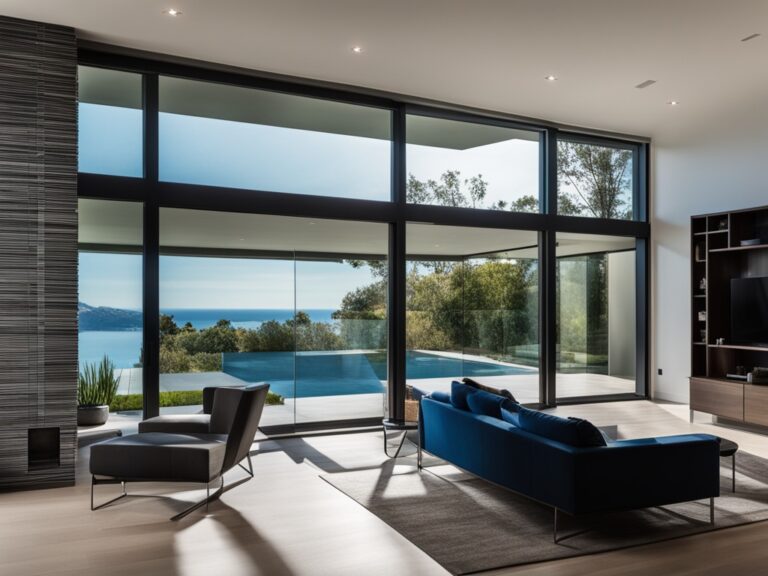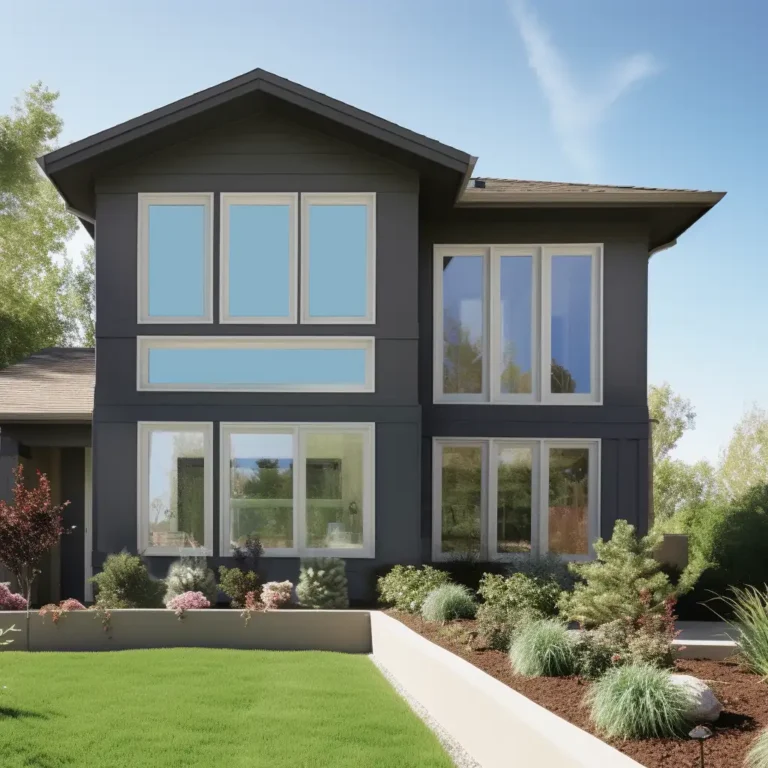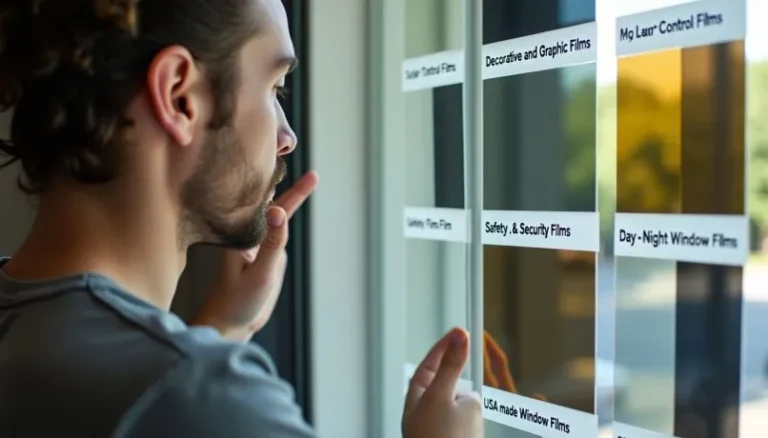Window Film for Heat Control – Beat the Heat with Solar Film
Window Film for Heat Control – Beat the Heat with Solar Film – Did you know that up to 30% of unwanted heat enters your home or office through windows? With the scorching summer temperatures in Australia, finding effective ways to reduce heat and create a comfortable indoor environment is essential. That’s where window film for heat control comes in. Not only does it help to block out a significant amount of solar heat, but it also reduces your reliance on air conditioning, resulting in lower cooling costs. Discover the benefits of window film and how it can make a noticeable difference in beating the heat.

Key Takeaways:
- Window film reduces heat entering your space by up to 30%.
- Window film helps lower cooling costs by reducing the reliance on air conditioning.
- Choosing the right window film can make a noticeable difference in improving comfort.
- Solar heat gain, reflective technology, and UV rays play a role in heat control.
- There are different types of window films available for heat control, including reflective, Non-reflective, and low-E films.
The Science Behind Window Film for Heat Reduction
Understanding how window film reduces heat requires a grasp of the science behind it. Solar heat gain refers to the amount of heat that enters a space through windows. Window film plays a crucial role in reducing solar heat gain by reflecting or absorbing a significant portion of this heat, preventing it from passing through the glass.
One of the key technologies used in window films is reflective technology. This technology allows the film to bounce off a significant amount of the sun’s rays, reducing the amount of heat transmitted indoors. By reflecting the sun’s heat away from the glass, reflective window films help keep the interior space cool and comfortable.
In addition to reducing heat, window films also play a crucial role in controlling UV rays. These harmful rays not only contribute to heat but can also cause fading and damage to furniture, flooring, and other interior furnishings. By blocking out a significant portion of UV rays, window films protect the interior space and help preserve the aesthetic appeal of your home or office.
| Technology | Solar Heat Reduction | UV Ray Protection |
|---|---|---|
| Reflective Window Film | High | High |
| Non-Reflective Window Film | Moderate | Moderate |
| Nanotechnology Window Film | High | High |
Types of Heat Control Window Films Explained
When it comes to heat control, different types of window films offer unique benefits. Understanding these options can help you select the right film for your needs. The three main types of heat control window films are:
Reflective Window Film
Reflective window film is specifically designed to reflect a significant amount of solar heat, helping to keep the interior cool and comfortable. This type of film features a mirrored or metallic appearance on the outside, which not only reduces heat but also provides privacy during the day.
Solar Gard Window Film
Solar Gard window film is known for its high-performance solar control properties. It effectively reduces heat by blocking out a substantial amount of solar energy and helps to improve energy efficiency. This type of film is designed to provide a comfortable environment while also protecting against harmful UV rays.
Low-E Window Films for Year-round Comfort
Low-E (low-emissivity) window films are an excellent choice for year-round comfort. These films help insulate the space by keeping heat out during the summer and retaining warmth indoors during the winter. By improving heat retention and reducing heat gain, low-E window films contribute to energy savings and create a more comfortable living or working environment.
Choosing the right type of heat control window film depends on your specific requirements and preferences. It’s important to consider factors such as the amount of heat reduction needed, the desired level of privacy, and the overall energy efficiency goals for your space.

Window Film for Heat as a Cooling Cost-Cutter
Choosing a window film for heat control can be a wise financial decision as it serves as a cooling cost-cutter. By reducing the amount of heat entering the space, window film reduces the reliance on air conditioning, which can lead to significant savings on cooling costs. The energy efficiency provided by window film helps to create a more sustainable and environmentally friendly living or working environment.
The Benefits of 3M™ Window Films for Your Home or Office
When it comes to window films, 3M™ is a trusted brand known for its high-quality products. Choosing 3M™ window films for your home or office provides numerous benefits that enhance both comfort and functionality.
One of the main advantages of 3M™ window films is their ability to reduce heat. These films are specially designed to block a significant amount of solar heat, keeping your indoor spaces cooler and more comfortable even on the hottest days. By reducing heat gain, 3M™ window films also help to decrease the reliance on air conditioning systems, resulting in energy savings and lower cooling costs.
In addition to heat reduction, 3M™ window films offer excellent protection against harmful UV rays. These films can block up to 99% of UV rays, which not only helps to keep your space cooler but also prevents fading and damage to furniture, flooring, and other interior furnishings. By installing 3M™ window films, you can prolong the life and appearance of your valuable belongings.
Improved energy efficiency is another significant benefit of 3M™ window films. These films act as insulation for your windows, reducing the transfer of heat in both hot and cold weather. This means that during winter, they help to retain warmth indoors and keep the cold air out, leading to cost savings on heating expenses as well.
Privacy is a crucial consideration for many homeowners and businesses. With 3M™ window films, you can enjoy enhanced privacy without sacrificing natural light. These films provide a one-way mirror effect during the daytime, making it difficult for people outside to see into your space while maintaining clear visibility from the inside.
Furthermore, 3M™ window films offer glare reduction, creating a more comfortable environment for working, studying, or relaxing. By reducing the amount of glare entering your space, these films help to minimize eyestrain and provide a clearer view of screens and monitors.
Safety is also a priority when it comes to window protection. 3M™ window films are designed to hold glass shards together in case of breakage, providing an added layer of safety and security. This feature not only protects occupants from injury but also helps to deter intruders and improve the overall strength of the window.
Overall, 3M™ window films offer a range of benefits for your home or office. From heat reduction and UV protection to improved energy efficiency and privacy, these films provide a cost-effective and durable solution. Consider installing 3M™ window films to enhance the comfort, safety, and functionality of your space.

Installing Window Film for Heat: DIY or Professional?
When it comes to installing window film for heat control, you have two options: the DIY route or hiring professional installation services. Each option comes with its own benefits and considerations, so let’s explore them to help you make an informed decision.
Tools You’ll Need for Self-Installation
If you choose to undertake the installation process yourself, there are a few essential tools you’ll need to ensure a successful and efficient installation:
- Spray bottle: Fill it with a solution of water and a few drops of mild dish soap to clean and prepare the window surface.
- Squeegee: Use it to remove any air bubbles and smooth the film onto the glass for a professional finish.
- Utility knife: This tool is necessary for trimming the film to fit the window dimensions accurately.
Benefits of Professional Installation Services
While DIY installation can be a rewarding endeavour, professional installation services offer several advantages that you should consider:
- Precision and Flawless Installation: Experienced installers have the expertise to ensure precise placement and flawless installation, maximizing the performance and longevity of the window film.
- Access to Advanced Equipment and Techniques: Professionals have access to advanced tools and techniques that result in a seamless finish, achieving professional-quality results that may be challenging to replicate as a DIY installer.
- Save Time and Effort: Hiring professional installation services eliminates the time and effort required for DIY installation, allowing you to focus on other tasks and responsibilities.
- Warranty and Guarantee: Professional installation services often come with warranties or guarantees, providing peace of mind and protection for your investment.
Ultimately, the choice between DIY installation and professional installation services depends on your skills, resources, and preferences. While DIY installation can be a cost-effective option, professional installation services offer the expertise and peace of mind that comes with a professional touch.
Optimizing Your Environment: Window Film for Heat Control and More
Window film for heat control offers additional benefits beyond reducing heat. In addition to keeping your space cool and comfortable, window film helps optimize your environment in various ways.
Glare Reduction and Increased Daytime Privacy
One of the key advantages of window film is its ability to minimize glare. Whether you’re working on a computer, watching television, or simply relaxing, excessive glare can be distracting and strain your eyes. Window film reduces the amount of glare that enters your space, creating a more comfortable and focused environment. Now, you can work or unwind without the annoyance of glare interfering with your activities.
Window film also enhances daytime privacy by reducing visibility from the outside. You can enjoy the natural light and clear visibility from the inside while maintaining a greater level of privacy. This is particularly beneficial for homes and offices located in busy areas or close proximity to neighbours.
Preserving Furniture and Interior from Harmful UV Rays
Another significant advantage of window film is its ability to protect your furniture and interior from harmful UV rays. UV rays not only contribute to heat but also cause fading and damage to your furnishings, including furniture, flooring, artwork, and textiles. Window film acts as a shield against these harmful rays, preventing premature fading and preserving the aesthetic appeal of your space. With window film, you can guard your investments and maintain the longevity of your interior decor.
Maintenance and Care of Window Films for Enduring Performance
Proper maintenance and care are crucial for ensuring the enduring performance of window films. By following these maintenance guidelines, you can extend the lifespan of your window film and continue to enjoy its benefits for years to come.
Cleaning: Regular cleaning is essential to keep your window film in optimal condition. Use non-abrasive materials and mild soapy water to remove dust and debris from the film’s surface. Avoid using abrasive cleaning agents or rough materials that can scratch or damage the film.
Sharp Objects and Tools: Be cautious when using any sharp objects or tools near the window film. Accidental contact with sharp edges can cause tears or punctures, compromising the film’s effectiveness and appearance.
Warranty: Check the warranty information provided by the manufacturer or installer for specific care instructions. Some window films may have specific requirements or restrictions that should be followed to maintain the warranty coverage.
“Proper care and maintenance of window films ensure their enduring performance and longevity.”
By following these simple maintenance guidelines, you can ensure that your window films continue to provide effective heat control, energy efficiency, and protection against harmful UV rays. Regular cleaning and careful handling will help maintain the film’s appearance and performance, keeping your home or office comfortable and protected.
Check out the image below to see the impact of window films on reducing heat and maintaining comfortable indoor temperatures:
Maximizing Energy Efficiency with the Right Window Tint
When it comes to maximizing energy efficiency in your space, choosing the right window tint is crucial. Window tinting offers a range of benefits, including heat control, reduced energy consumption, and improved comfort. By selecting the appropriate tint for your windows, you can effectively regulate the amount of heat entering your space, resulting in significant energy savings and enhanced overall efficiency.
Comparing Tint Levels for Best Heat Control
Window tints come in various levels, each offering a different degree of heat control. Generally, darker tints provide higher heat reduction by absorbing and reflecting a greater amount of solar heat. Lighter tints, on the other hand, let in more natural light but may not provide as much heat control as darker alternatives. When choosing a tint level, it’s important to consider your specific needs, preferences, and climate conditions to ensure optimal heat regulation.
Understanding VLT and Its Impact on Energy Use
Visible Light Transmission (VLT) is a crucial factor to consider when selecting a window tint. VLT refers to the percentage of natural light that can pass through the tinted windows. It directly affects the amount of light that enters your space and consequently impacts the overall energy use. Higher VLT values allow more light to enter, reducing the need for artificial lighting during the day. By striking the right balance between heat control and VLT, you can optimize energy efficiency, minimize reliance on electrical lighting, and create a comfortable environment.
Maximizing energy efficiency through the selection of the right window tint involves careful consideration of both tint levels and VLT. By choosing a tint that effectively controls heat while allowing an appropriate amount of natural light, you can achieve significant energy savings, reduce your carbon footprint, and create a more sustainable living or working environment.
| Tint Level | Heat Reduction | Visible Light Transmission (VLT) |
|---|---|---|
| Light | Minimal | Higher (More natural light) |
| Medium | Moderate | Medium (Balanced light and heat control) |
| Dark | Significant | Lower (Reduced natural light) |
Conclusion
In conclusion, window film for heat control is an effective and practical solution to combat the scorching Australian heat while reducing cooling costs and enhancing comfort in your home or office. By understanding the science behind window film, exploring the different types available in the market, and considering reputable brands like 3M™, you can make an informed decision to create a more comfortable indoor environment.
Whether you choose to install window film yourself or opt for professional installation services, the benefits go beyond heat control. Window film can also reduce glare, providing a more pleasant working or relaxing environment. Additionally, it offers increased privacy by reducing visibility from the outside while maintaining clear visibility from the inside. Furthermore, window film protects your interior furnishings and surfaces from the damaging effects of harmful UV rays, ensuring their longevity.
Maximizing energy efficiency is another advantage of using window film for heat control, resulting in cost savings and a more sustainable living or working space. With proper maintenance and care, window films can provide enduring performance, keeping your space comfortable and energy-efficient for years to come. So, don’t wait any longer—invest in window film for heat control and enjoy the benefits of a cool, cost-effective, and comfortable indoor environment.
FAQ
What is window film for heat control?
Window film for heat control is a solution that helps reduce the amount of heat that enters your home or office through windows. It provides a cost-effective and energy-efficient way to make your space more comfortable and lower cooling costs.
How does window film for heat reduction work?
Window film for heat reduction works by reflecting or absorbing solar heat, preventing it from passing through the glass. This helps to keep your space cooler by reducing the amount of heat that enters, providing a more comfortable environment year-round.
What types of window films are available for heat control?
There are several types of window films available for heat control. Reflective window films are designed to reflect a significant amount of solar heat. Solar Gard window films are known for their high-performance solar control properties. Low-E (low-emissivity) window films provide insulation, keeping heat out in summer and retaining warmth in winter.
How can window film for heat control help reduce cooling costs?
Window film for heat control reduces the amount of heat entering your space, which reduces the reliance on air conditioning. By using less energy for cooling, you can save on cooling costs while still maintaining a comfortable environment.
What are the benefits of 3M window films for my home or office?
Choosing 3M window films for your home or office offers several benefits. These films not only reduce heat but also block out harmful UV rays, provide enhanced privacy, reduce glare, and offer added safety by holding glass shards together in case of breakage.
Can I install window film for heat control myself?
Yes, you can install window film for heat control yourself. You’ll need tools like a spray bottle, squeegee, and a utility knife for an efficient installation process. However, professional installation services offer benefits such as precise installation, advanced equipment, and techniques that result in a seamless finish.
What additional benefits does window film for heat control provide?
Window film for heat control not only reduces heat but also helps to minimize glare and increase daytime privacy. It also protects your furniture and interior from the damaging effects of harmful UV rays, preventing fading and preserving the aesthetic appeal of your space.
How do I maintain and care for window films?
Proper maintenance and care are essential for ensuring the enduring performance of window films. Regular cleaning with non-abrasive materials and mild soapy water is recommended. Avoid using abrasive cleaning agents or rough materials that can scratch or damage the film.
How do tint levels impact heat control and energy use?
Tint levels in window films impact the amount of heat control they provide, with darker tints offering higher heat reduction. Visible Light Transmission (VLT) percentage is also important, as it determines the amount of natural light allowed through the tinted windows. Finding the right balance between heat control and VLT can result in significant energy savings and improved comfort.
Why should I consider window film for heat control?
Choosing window film for heat control is a practical and efficient solution to beat the heat, reduce cooling costs, and enhance comfort in your home or office. It provides energy efficiency, glare reduction, increased privacy, and protection against harmful UV rays, contributing to a comfortable and cost-effective living or working space. ###
Q: What is solar reflective window film?
A: Solar reflective window film is a type of window coating that is designed to reduce heat from the sun, making it an effective solution for heat control in homes and offices.
Q: How does solar reflective window film help in reducing heat?
A: Solar reflective window film works by reflecting a portion of the sun’s heat away from the windows, reducing the amount of radiant heat that enters the building and improving insulation. This helps maintain a more comfortable indoor environment and can also lead to energy savings by reducing the need for excessive cooling.
Q: What are the benefits of using solar-reflective window film?
A: Using solar reflective window film provides several benefits, such as reducing energy bills, improving temperature control, making your home or office more energy efficient, and protecting furnishings from the sun’s damaging UV rays.
Q: How does the application of solar reflective window film contribute to energy efficiency?
A: Solar reflective window film helps improve energy efficiency by reducing the amount of solar heat that enters the building, thereby lessening the load on air conditioning systems and reducing the need for excessive cooling. This can result in lower energy costs and a more sustainable approach to heating and cooling.
Q: Can solar reflective window film be applied to existing windows?
A: Yes, solar reflective window film can be applied to existing windows, whether they are double-pane, single-pane, or even triple-pane, providing an effective and cost-efficient alternative to expensive cooling costs.
Q: Is solar reflective window film suitable for all types of windows?
A: Solar reflective window film is suitable for a wide range of windows, including clear and tinted ones, and can be particularly beneficial for homes and offices without the need for expensive window upgrades like upgrading to double glazing.
Q: How do 3M™ window films improve heat control?
A: 3M™ window films, including low-e window films, are designed to absorb the sun’s heat and retain heat during colder months, providing year-round heat control and promoting energy efficiency in both residential and commercial settings.
Q: What are the advantages of using 3M™ solar films for heat control?
A: 3M™ solar films offer effective heat control, helping to make homes cooler, reducing energy costs, and enhancing the overall comfort and livability of the indoor environment, all without compromising the natural light coming through the windows.
Q: How can I get more information about solar reflective window film for my home or office?
A: For further information and to explore the options for solar reflective window film for your home or office, you can get in touch with authorized suppliers or visit the official website of 3M Australia to learn about the range of products and solutions available.
Q: Are there other considerations to keep in mind when choosing solar reflective window film for heat control?
A: When considering solar reflective window films, it’s important to assess specific needs and preferences, such as the level of solar heat reduction, the appearance of the film, and the potential impact on natural light, to ensure the best fit for maintaining a comfortable and energy-efficient indoor environment.







